Beech Trees: Types, Leaves, Bark — Identification Guide (Pictures)

Beech trees (botanical name Fagus) are tall deciduous shade trees with lime green ovate leaves, creating a dense, rounded crown. All varieties of beech trees produce small clusters of yellow-green flowers, followed by beech tree fruit or beechnuts. In the fall, beech tree foliage turns from green to beautiful autumn shades of orange, yellow, and golden brown. Beech trees are grown in large landscapes. The tall trees provide shade or are planted in rows to create privacy hedges or screens.
There are only 13 species of beech trees, most of which belong to the genus Fagus. A few Asian beech tree species are in the subgenus Engleriana. The most common types of beech trees are the American beech tree (Fagus grandifolia) and the European beech tree (Fagus sylvatica).
Beech trees are easy-care, versatile trees that thrive in various conditions. Native to temperate climates in North America and Europe, beech trees grow in rich, fertile soil with excellent drainage. As a beautiful landscape tree, beech tree varieties are relatively resistant to pests, disease, and deer.
This article is a guide to identifying the various species of beech trees. Descriptions of beech tree leaves, flowers, fruit, and bark will help to recognize various types of Fagus.
Beech Tree Leaves
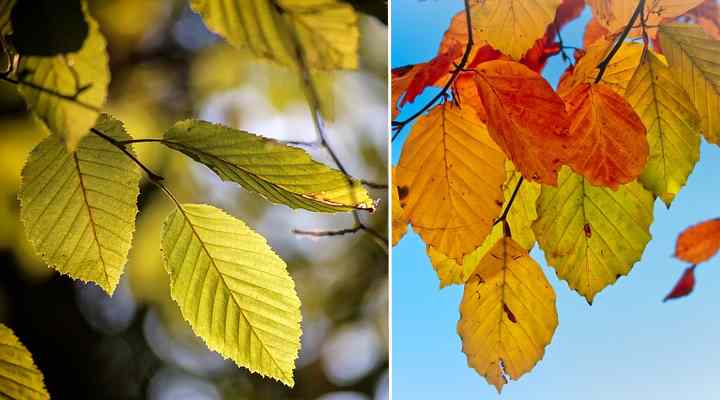
Beech tree leaves and autumn foliage (right)
Beech tree leaves are identified by their glossy dark green color, ovate to elliptical shape, and finely toothed margins. Young beech leaves look lime green with fine hairs on the edges. In fall, the smooth dark green blades turn stunning bronze, copper, or yellow shades. Leaves of beech trees grow between 2” and 6” (5 – 15 cm) long and up to 4” (10 cm) wide.
One way to identify beech leaves is by examining the blade’s veins. Beech trees have parallel leaf veins from the midriff to the blade’s edge. The side veins end in a distinctive point, giving the beech leaf a slightly serrated look.
A notable feature of beech tree leaves is their dense growth on the tree. The compact beech foliage, the shiny green leaves that turn golden brown, along with the tree’s tall stature, make beech trees ideal landscaping shade trees.
Beech Tree Bark
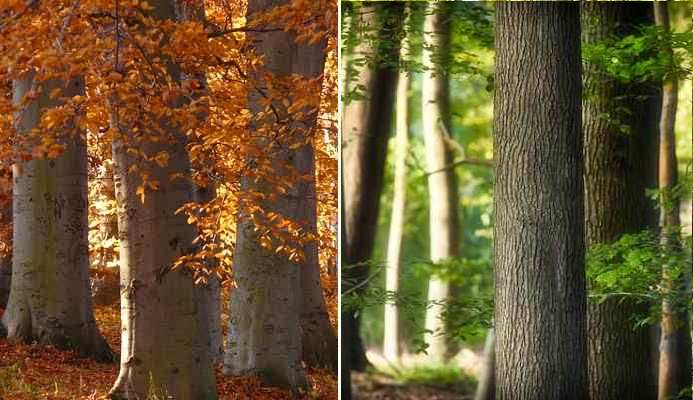
Examples of beech tree bark
Beech tree bark is identifiable by its smooth, light gray appearance. As beech trees mature, the bark gradually develops slight fissures. On mature trees, beech bark looks like it has ridges or shallow cracks running horizontally on the long, straight tree trunk. In winter landscapes, a beech tree is recognizable due to its beautiful, silvery-gray bark.
Beech Tree Flowers
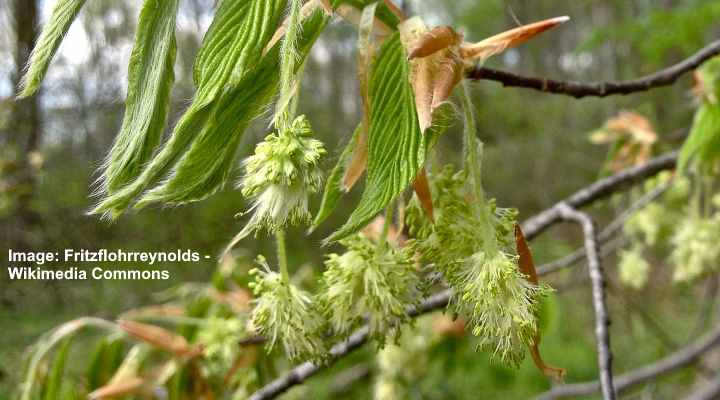
American beech flowers
Beech trees produce small spidery flowers in mid to late spring after new leaves appear. Flowers on beech trees are monoecious, meaning there are male and female flowers on the same tree.
The male beech flowers are catkins that look like clusters of globular heads with spindly filaments. These fuzzy-looking flowers droop down on the ends of short petioles (stems).
Female beech flowers grow in pairs without any stalk (petiole) and stand erect above the dangling clusters of male flowers.
The overall appearance of beech tree flowers is yellowish-green insignificant, pendulous spindly catkins that appear in spring.
Beech Tree Fruit
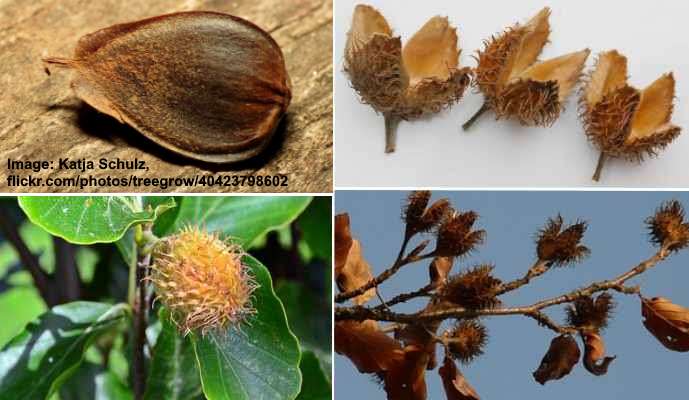
Beech tree fruit (beechnut) on top left and the spiky husks
Beech tree fruit, also called beechnuts, are identifiable by their brown color and unique three-angled look. The fruit (nuts) from beech trees are triangular in appearance and are contained in spiky husks called cupules. The distinctive appearance of beechnuts is a common way to identify beech trees.
Beech Tree Identification
Identifying beech trees is possible by looking at the leaves, bark, and tree’s unique looking fruit. Beech tree leaves are shiny and dark ovate-shaped with a pointed tip. Also, look for straight parallel veins running from the midriff to the blade’s toothed edges. Beech trees have a distinctive smooth silvery-gray bark, making them easy to identify beech trees in winter.
Types of Beech Trees
Beech trees are easy to tell apart from species of other deciduous trees. There are also some differences between the most common varieties of beech trees. Please read on to find out how to identify various beech tree species.
American Beech Tree (Fagus grandifolia)
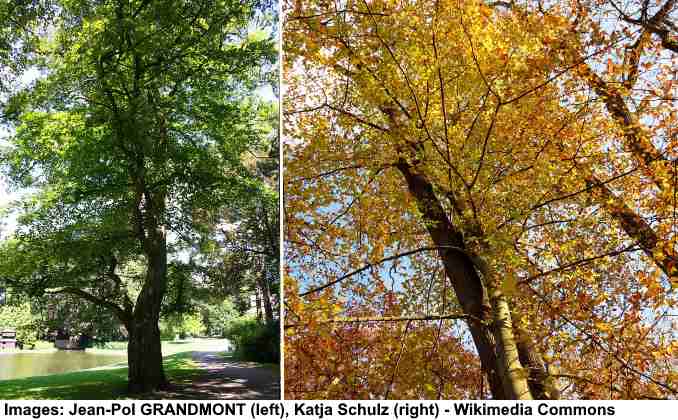
American beech tree (Fagus grandifolia)
The American beech tree is a tall deciduous hardwood tree with large, glossy green leaves, smooth light-gray bark, and a rounded, spreading crown. As a beautiful shade tree, the American beech grows between 60 and 80 ft. (18 – 24 m) tall and up to 80 ft. (24 m) wide.
American beech trees provide plenty of interest in all seasons. Their magnificent fall colors range from golden yellow to copper and bronze. The smooth gray bark and zig-zagging branches add winter appeal. In spring and summer, large glossy green leaves provide plenty of shade in large, open landscapes.
Fagus grandifolia thrives in USDA zones 3 – 9. The tall tree grows best in moist, well-drained soil and full sun or partial shade.
As with all beech trees, the American beech produces insignificant yellowish-green flowers in spring. The Fagus grandiflora has fruit in the form of three-sided edible beechnuts found inside soft, spiky seed cases.

American beech fruit
There is only one species of American beech tree. The many beech tree cultivars are primarily from the European beech tree Fagus sylvatica.
If you plan to grow an American beech in your landscape, there are a few things to remember. First, the tree doesn’t perform well in compacted soil or urban environments. Additionally, its sizeable spreading crown means it needs plenty of room to grow. However, the low-growing, horizontal branches and dense foliage make the American beech an impressive landscape tree if you have space.
American beech tree leaf

American beech leaves
Leaves on American beech trees look elliptical to ovate shape with a glossy shine and pointed tip. The broad leaves measure 3” – 6” (7.5 – 15 cm) long and up to 3” wide (7.5 cm). The leaf margins look serrated, and there are straight parallel veins visible on the leaf. The simple tree leaves grow alternately on light gray branches.
In the fall, American tree leaves turn from dark green to coppery-bronze hues.
The tree’s botanical name, Fagus grandiflora, refers to the beech tree’s large leaves.
American beech tree bark
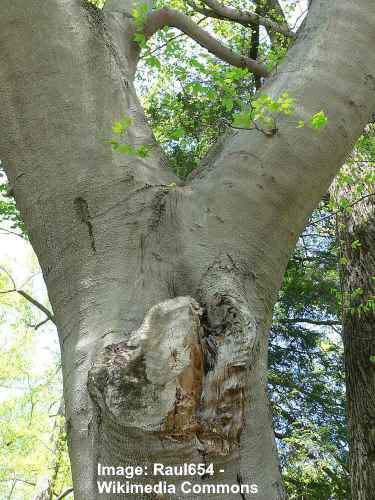
American beech bark
Bark of American beech trees stays light, silvery-gray, and smooth as the tree matures. A problem with Fagus grandiflora is beech bark disease. This is a fungal disease caused by the beech scale insect Cryptococcus fagisuga.
American beech tree care
Grow the American beech tree in deep, fertile, well-draining soil and full sun to partial shade. This prevents shallow roots from sending up suckers and helps prevent fungi. It’s a good idea to remove suckers and prune the tree annually in late winter or early spring.
European Beech (Fagus sylvatica)
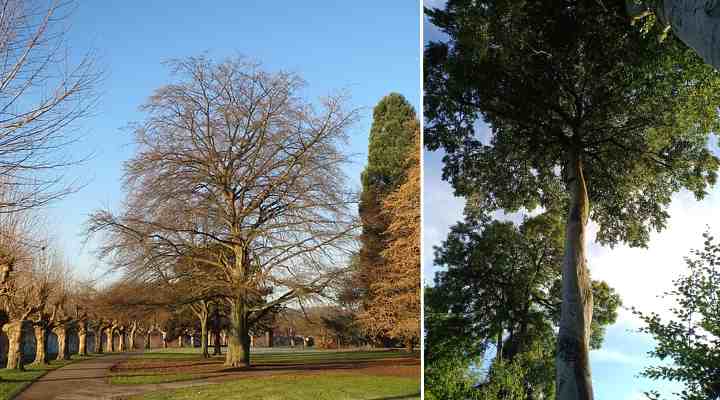
European beech trees (Fagus sylvatica)
The European beech tree is a beautiful deciduous landscape tree with dense foliage of large green leaves forming a pyramidal to rounded crown. The tree’s broadly elliptic shiny leaves emerge pale green in spring, turn dark green in summer, then become rich golden brown in the fall. European beech trees grow between 40 and 60 ft. (12 – 18 m) tall.
European beech trees grow best in USDA zones 4 – 9. As with all beech trees, the European specimen performs best in full sun or partial shade. However, this variety grows well in compacted ground. This makes it more suitable for growing in active landscapes where there’s more foot traffic.
Compared to the American beech tree, the native European species is somewhat smaller. Despite being a large landscaping tree, it doesn’t need as much room as the American beech. Growing in deep, rich soil, the European beech grows as a specimen tree or hedge plant.
It is easy to tell apart the European beech tree from the American beech. The European beech is identified as a smaller tree species. It has dark gray, not light gray, bark, and shorter leaves with wavy, non-serrated margins.
In deciduous woodlands and parks, you can identify the European beech by the bristly seed cases that contain hard-shelled, triangular edible kernels.
European beech tree leaf

European beech leaves
Leaves on European beech trees are identified by their ovate shape, smooth, hairless blades, and glossy appearance. The beech tree leaves are dark green in summer and turn to hues of red, burgundy, copper, and yellow in the fall.
The simple, ovate-elliptic leaves measure 6” (15 cm) long and wide. Leaves are arranged alternately on dark gray branches. There is no serration along the leaf’s wavy edges.
European beech tree bark
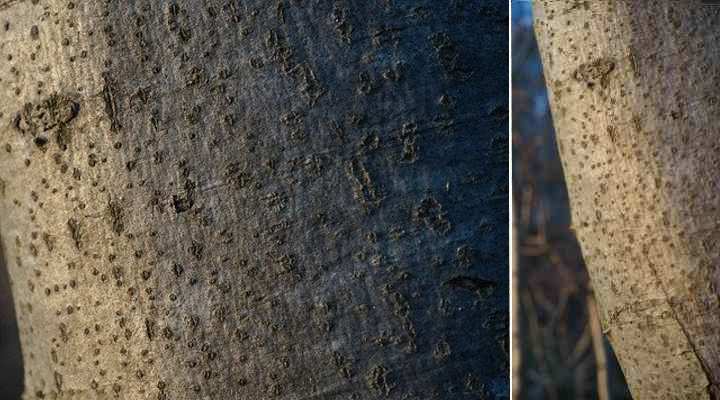
European beech bark
The bark of the European beech tree is smooth and dark gray. Even though its bark becomes slightly rougher as the tree matures, European beech tree bark doesn’t become scaly and fissured.
European beech tree care
Grow the slow-growing European beech tree in full sun to partial shade. The best kind of location is slightly alkaline soil that is loose and loamy with excellent drainage. Water the ground enough to keep it moist, especially in dry conditions as beech trees aren’t tolerant of drought.
Copper Beech Tree (Fagus sylvatica ‘Purpurea’)
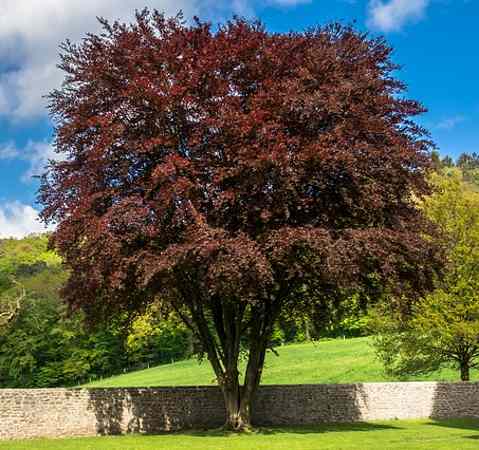
Copper beech tree (Fagus sylvatica ‘Purpurea’)
Also called the purple beech tree, the copper beech has a vast spreading crown made up of purple or coppery-colored leaves. The spectacular deciduous landscape tree grows between 50 and 60 ft. (15 – 18 m) tall. Its gray bark provides winter interest. In summer, the dense foliage makes this an excellent shade tree.
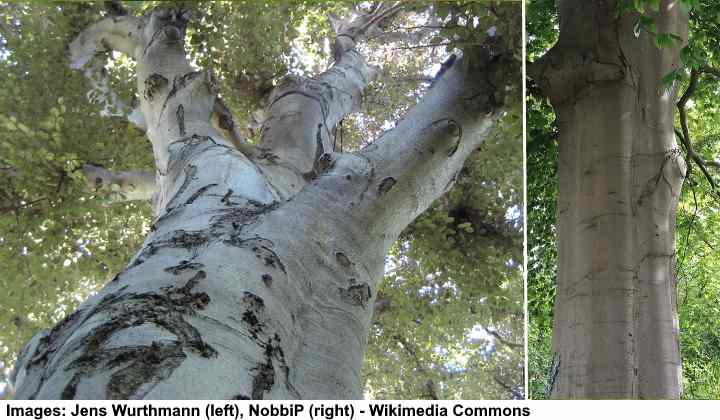
Copper beech bark
The Fagus sylvatica ‘Purpurea’ thrives in full to partial sun in USDA zones 5 – 9.
The beautiful copper colored leaves of copper beech tree give Fagus sylvatica its common name. The broadly ovate serrated leaves are a spectacular dark purple color in early spring and summer. In the fall, the leaves of copper beech tree turn dark green before becoming golden yellow. Like all species of Fagus sylvatica, the smooth, shiny leaves have a wavy margin without teeth.

Copper beech leaves
If you have a compact garden, you can grow the Fagus sylvatica ‘Purpurea Nana.’ This dwarf beech tree has all the attractive characteristics of the taller copper beech tree. The intense spring and summer purple leaves turn to warm copper tones in the fall. This small landscaping beech tree matures at around 12 ft. (3.5 m) tall and 8 ft. (2.4 m) wide.
Weeping Beech (Fagus sylvatica ‘Pendula’)
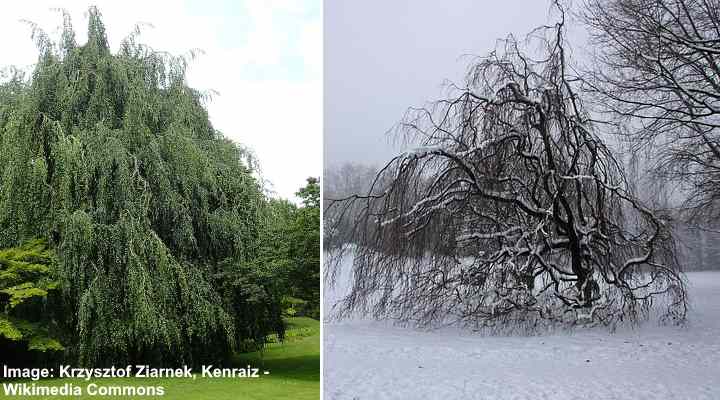
Weeping beech trees (Fagus sylvatica ‘Pendula’)
The weeping beech is a beautiful deciduous tree identified by its drooping gray branches, dark green broadly elliptic leaves, and a broad crown. Like all beech trees, the weeping beech produces small spindly yellowish flowers. Weeping beech trees grow between 35 and 50 ft. (11 – 15 m) tall and up to 40 ft. (12 m) wide.
The weeping beech tree has a simple elliptic appearance of the leaves. The smooth, glossy leaves turn a coppery-brown color in the fall. After the leaves drop, the gray bark provides stunning visual appeal in winter landscapes.
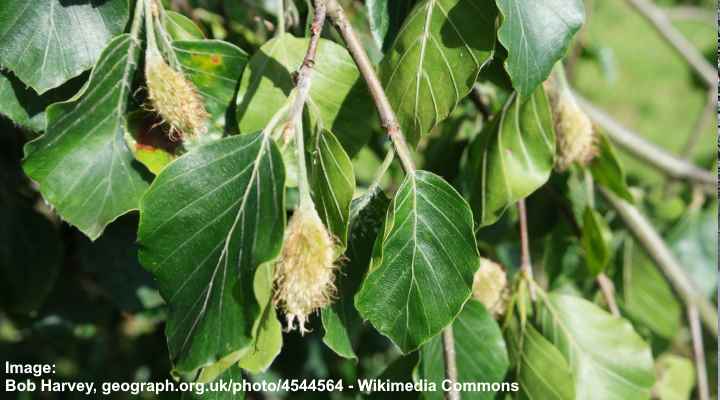
Weeping beech leaves
Weeping beech trees grow best in USDA zones 4 – 7. Grow this weeping landscape tree in full sun and deep, loose soil that is kept moist but never soggy.
Many people regard the weeping beech as one of the best ornamental trees for large landscapes.
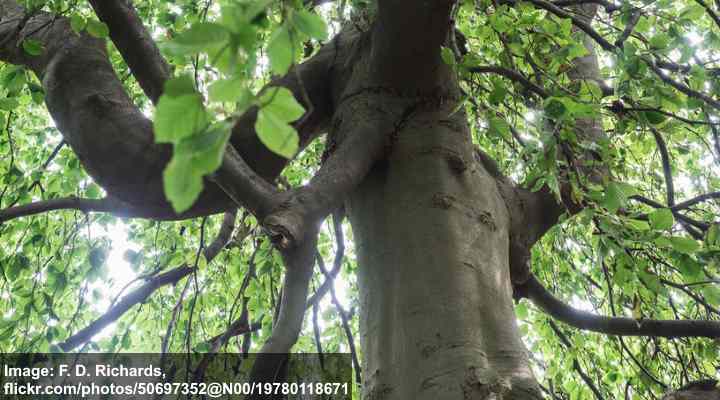
Weeping beech bark
Tricolor Beech (Fagus sylvatica ‘Purpurea Tricolor’)
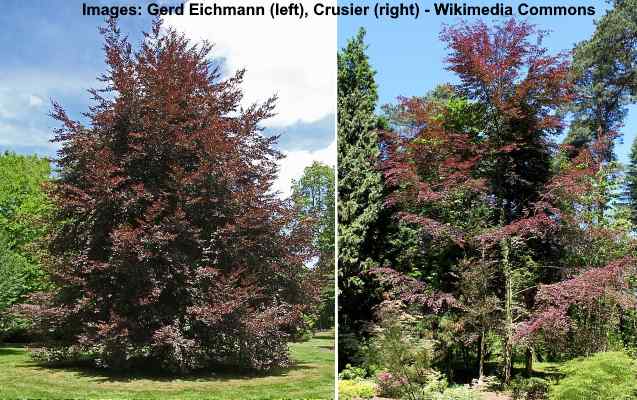
Tricolor beech trees (Fagus sylvatica ‘Purpurea Tricolor’)
The tricolor European beech tree has superb dark purple and pink variegated leaves, smooth gray bark, and small clusters of spidery flowers. The tricolor beech is one of the small species of beech tree, growing between 20 and 30 ft. (6 – 9 m) tall. The tricolor beech is a suitable lawn specimen tree or hedge plant in USDA zones 4 – 7.
The tricolor leaves are the outstanding feature of this Fagus species. Purple leaves with pink edges that become dark green with white margins help identify this beech tree. In fall, the 4-inch (10-cm) long, ovate leaves turn a brilliant golden color.
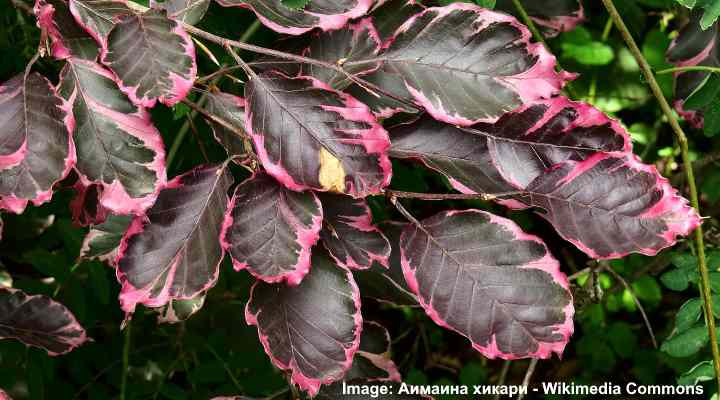
Tricolor beech leaves
The pink foliage of the tricolor beech tree can get scorched in the hot sun. So, it’s best to grow this easy-care beech in partial sun and ensure the well-draining ground is kept consistently moist.
Common Beech ‘Dawyck Purple’ (Fagus sylvatica ‘Dawyck Purple’)

Young common beech ‘Dawyck Purple’ tree (Fagus sylvatica ‘Dawyck Purple’)
The ‘Dawyck Purple’ European beech is a medium-sized columnar tree with dark purple leaves, light gray bark, and small yellowish-green flowers. This deciduous landscape tree is suitable for growing as a specimen tree or dark-leaved screen. The upright beech tree grows between 25 and 50 ft. (7 – 15 m) tall and up to 15 ft. wide.
The identifying characteristic of the ‘Dawyck Purple’ beech is its dark, shiny, broadly elliptic leaves. The beech leaves emerge as reddish-purple blades and become dark purple during summer. In fall, the beech foliage turns an eye-catching golden-bronze color.
The ‘Dawyck Purple’ beech tree is suitable for medium to large garden landscapes in USDA zones 4 – 7. The columnar beech tree grows best in full sun or partial shade and deep, fertile, moist soil.
If you’re looking for a spectacular purple-leaved landscaping tree, then the ‘Dawyck Purple’ European beech is an excellent choice.
Fern-Leaved Beech (Fagus sylvatica ‘Asplenifolia’)

Fern-leaved beech tree (Fagus sylvatica ‘Asplenifolia’)
The appropriately named fern-leaved beech has soft, feathery fern-like leaves forming a dense pyramidal to rounded crown. As a tall landscape tree, the fern-leaved beech grows between 60 and 80 ft. (18 – 24 m) tall and up to 50 ft. (15 m) wide. In USDA zones 4 – 7, the ‘Asplenifolia’ beech tree thrives in full sun or partial shade.
The fern-leaved beech tree is easily identifiable due to its unique leaves. Unlike other beech species, the leaves are long and narrow, with pointed lobes on the margins. Each of the slender triangular leaves has a tapered point. The beech leaves are dark green throughout the summer before turning golden yellow in the fall.
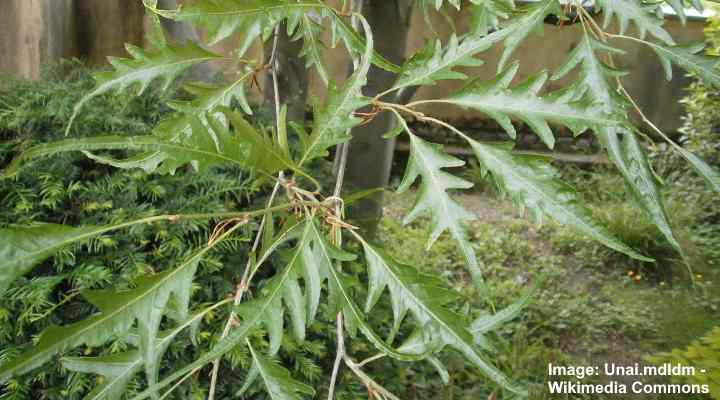
Fern-leaved beech leaves
Other identifying features of the fern-leaved beech are small yellowish flower clusters that appear in spring and triangular beechnuts encased in spiky husks that drop in the fall.
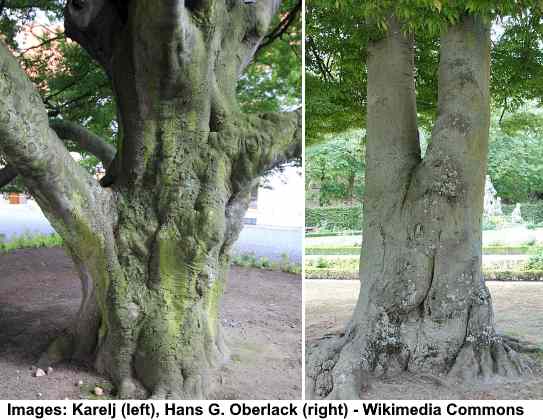
Bark of old fern-leaved beech tree
Japanese Beech (Fagus crenata)
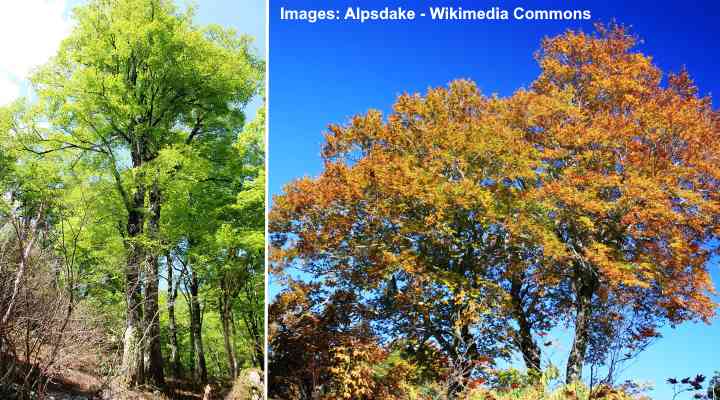
Japanese beech trees (Fagus crenata)
The Japanese beech tree is native to Asia and one of the most common trees in deciduous forests. Also called Siebold’s beech or buna, the Japanese beech has smooth gray bark, dark green ovate, pointed leaves with serrated edges, and tiny spring flowers. You can recognize the Japanese beech by its low-branching growth and large, spreading rounded crown.
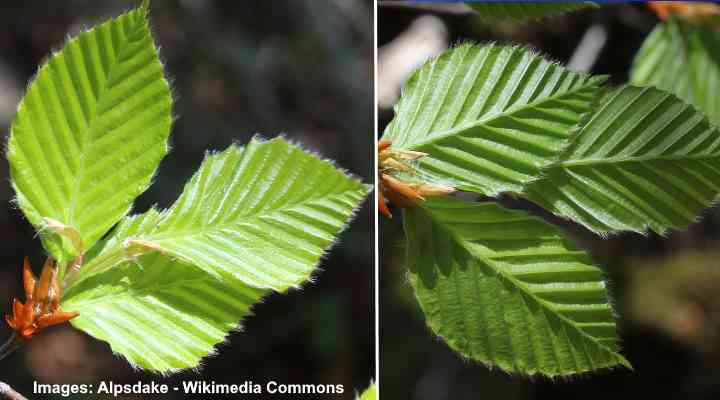
Japanese beech leaves front (left) and back (right)
The Japanese beech thrives in USDA zones 4 – 7. Growing in full sun to partial shade, the beech tree performs best in loose, loamy soil with good drainage.
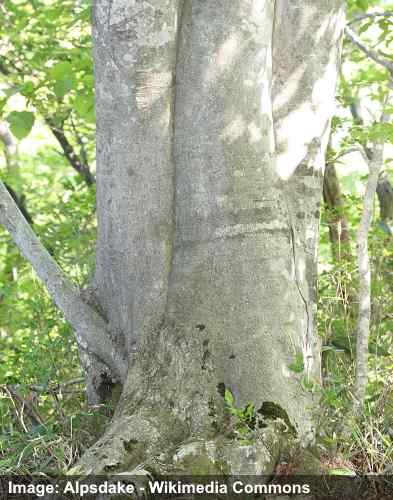
Japanese beech bark
Related articles:
